Attached files
| file | filename |
|---|---|
| 8-K - FORM 8-K - EQUITY LIFESTYLE PROPERTIES INC | d201431d8k.htm |
Exhibit 99.1

Equity LifeStyle Properties
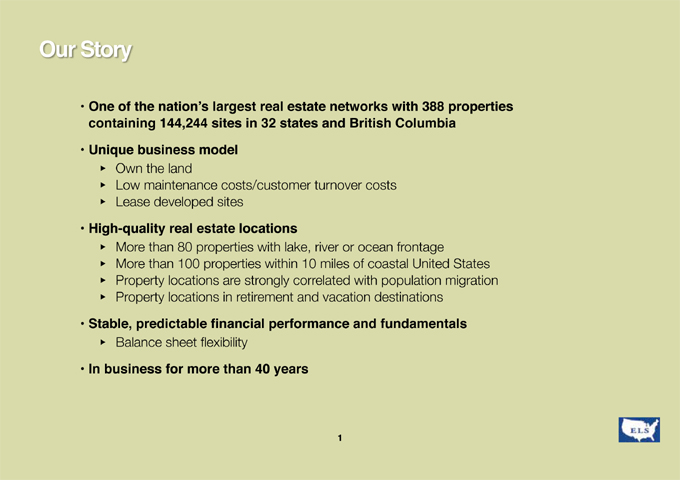
Our Story 1 One of the nation’s largest real estate networks with 388 properties containing 144,244 sites in 32 states and British Columbia Unique business model Own the land Low maintenance costs/customer turnover costs Lease developed sites High-quality real estate locations More than 80 properties with lake, river or ocean frontage More than 100 properties within 10 miles of coastal United States Property locations are strongly correlated with population migration Property locations in retirement and vacation destinations Stable, predictable financial performance and fundamentals Balance sheet flexibility In business for more than 40 years
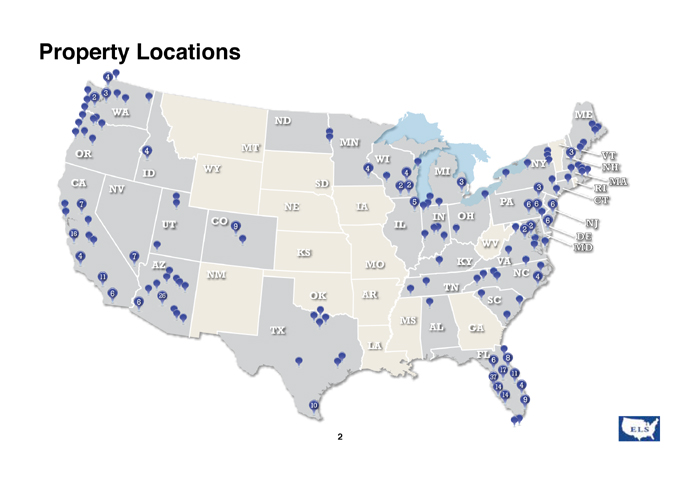
Property Locations WA OR CA NV ID UT AZ NM TX OK LA AR MO IA MN WI IL OH MI PA WV KY TN MS AL GA FL SC NC MD DE ME NY VA KS NE SD ND MT WY CO 6 6 6 3 3 9 4 4 4 4 2 2 3 2 8 17 37 11 9 7 7 26 6 6 11 4 16 14 14 4 6 5 10 IN
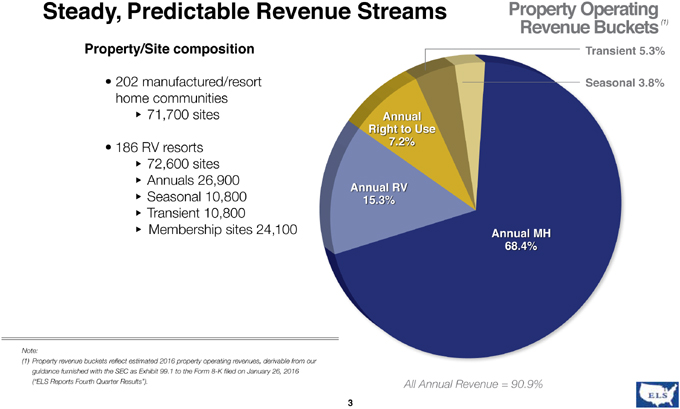
Steady, Predictable Revenue Streams Property/Site composition • 202 manufactured/resort home communities 71,700 sites • 186 RV resorts 72,600 sites Annuals 26,900 Seasonal 10,800 Transient 10,800 Membership sites 24,100 Annual Right to Use 7.2% Annual RV 15.3%Annual MH 68.4% Note: (1) Property revenue buckets reflect estimated 2016 property operating revenues, derivable from our guidance furnished with the SEC as Exhibit 99.1 to the Form 8-K filed on January 26, 2016 (“ELS Reports Fourth Quarter Results”). 3 Property Operating Revenue Buckets(1) Transient 5.3% Seasonal 3.8% All Annual Revenue = 90.9%
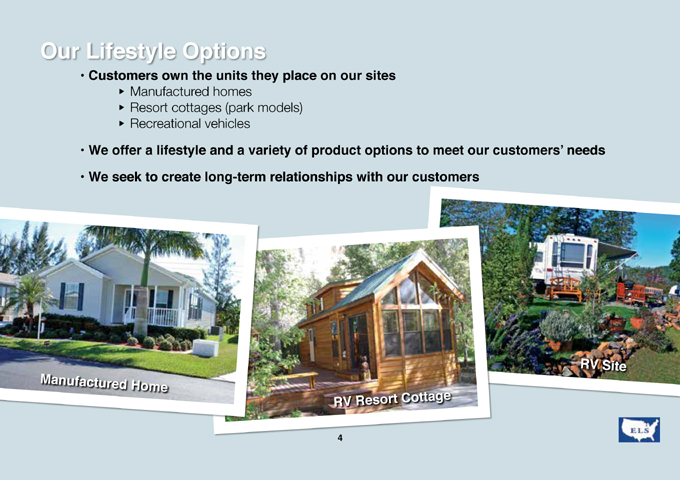
Our Lifestyle Options Customers own the units they place on our sites Manufactured homes Resort cottages (park models) Recreational vehicles • We offer a lifestyle and a variety of product options to meet our customers’ needs • We seek to create long-term relationships with our customers Manufactured Home RV Resort Cottage RV Site
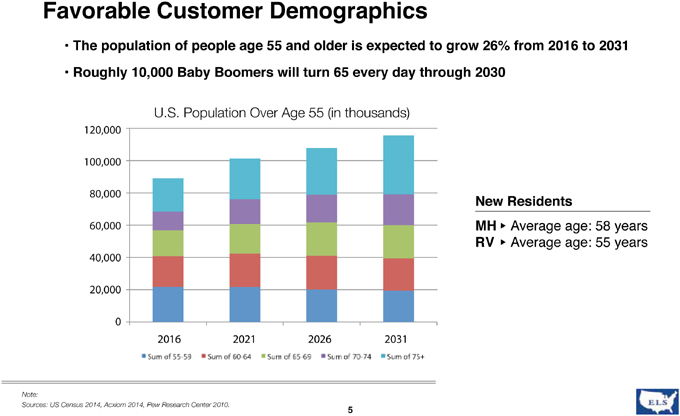
Favorable Customer Demographics • The population of people age 55 and older is expected to grow 26% from 2016 to 2031 • Roughly 10,000 Baby Boomers will turn 65 every day through 2030 U.S. Population Over Age 55 (in thousands) New Residents MH Average age: 58 years RV Average age: 55 years 120,000 100,000 U.S. Population Over Age 55 (in thousands) Sum of 55-59 Sum of 60-64 Sum of 65-69 Sum of 70-74 Sum of 75+ 80,000 60,000 40,000 20,000 0 Note: Sources: US Census 2014, Acxiom 2014, Pew Research Center 2010.
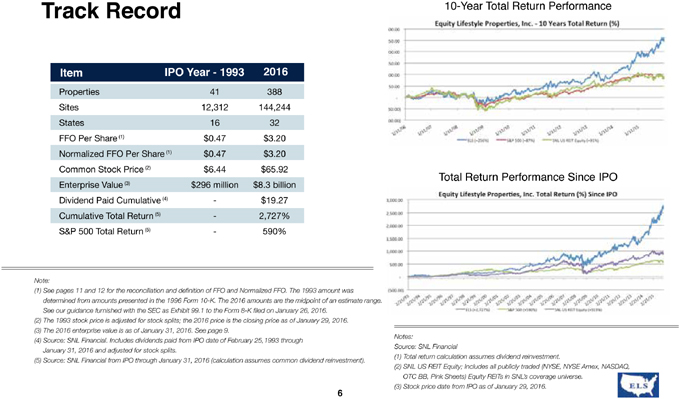
Track Record Item IPO Year—1993 2016 Properties Sites States FFO Per Share (1) Normalized FFO Per Share (1) Common Stock Price (2) Enterprise Value (3) Dividend Paid Cumulative (4) Cumulative Total Return (5) S&P 500 Total Return (5) 41 12,312 16 $0.47 $0.47 $6.44 $296 million ——388 144,244 32 $3.20 $3.20 $65.92 $8.3 billion $19.27 2,727% 590% Note: (1) See pages 11 and 12 for the reconciliation and definition of FFO and Normalized FFO. The 1993 amount was determined from amounts presented in the 1996 Form 10-K. The 2016 amounts are the midpoint of an estimate range. See our guidance furnished with the SEC as Exhibit 99.1 to the Form 8-K filed on January 26, 2016. (2) The 1993 stock price is adjusted for stock splits; the 2016 price is the closing price as of January 29, 2016. (3) The 2016 enterprise value is as of January 31, 2016. See page 9. (4) Source: SNL Financial. Includes dividends paid from IPO date of February 25,1993 through January 31, 2016 and adjusted for stock splits. (5) Source: SNL Financial from IPO through January 31, 2016 (calculation assumes common dividend reinvestment 10-Year Total Return Performance Total Return Performance Since IPO Notes: Source: SNL Financial (1) Total return calculation assumes dividend reinvestment. (2) SNL US REIT Equity; Includes all publicly traded (NYSE, NYSE Amex, NASDAQ, OTC BB, Pink Sheets) Equity REITs in SNL’s coverage universe. (3) Stock price date from IPO as of January 29, 2016.
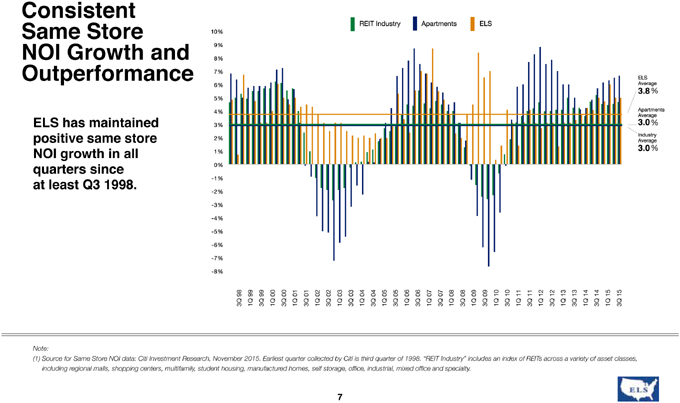
Consistent Same Store NOI Growth and Outperformance ELS has maintained positive same store NOI growth in all quarters since at least Q3 1998. 3Q 98 1Q 99 3Q 99 1Q 00 3Q 00 1Q 01 3Q 01 1Q 02 3Q 02 1Q 03 3Q 03 1Q 04 3Q 04 1Q 05 3Q 05 1Q 06 3Q 06 1Q 07 3Q 07 1Q 08 3Q 08 1Q 09 3Q 09 1Q 10 3Q 10 1Q 11 3Q 11 1Q 12 3Q 12 1Q 13 3Q 13 1Q 14 3Q 14 1Q 15 3Q 15 3.8% 3.0% 3.0% Note: (1) Source for Same Store NOI data: Citi Investment Research, November 2015. Earliest quarter collected by Citi is third quarter of 1998. “REIT Industry” includes an index of REITs across a variety of asset classes, including regional malls, shopping centers, multifamily, student housing, manufactured homes, self storage, office, industrial, mixed office and specialty
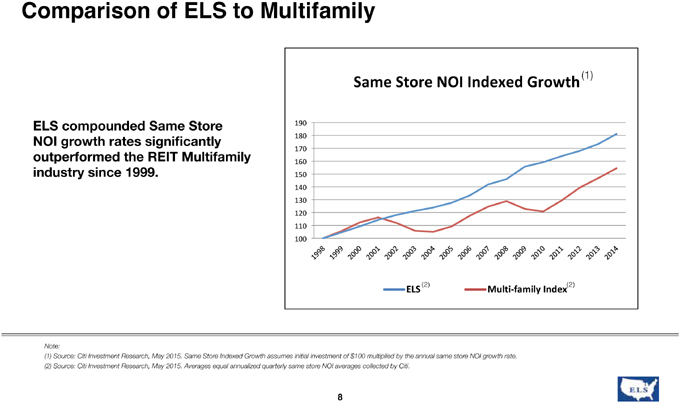
Comparison of ELS to Multifamily ELS compounded Same Store NOI growth rates significantly outperformed the REIT Multifamily industry since 1999 Same Store NOI Indexed Growth (1)( Note: (1) Source: Citi Investment Research, May 2015. Same Store Indexed Growth assumes initial investment of $100 multiplied by the annual same store NOI growth rate. (2) Source: Citi Investment Research, May 2015. Averages equal annualized quarterly same store NOI averages collected by Citi.
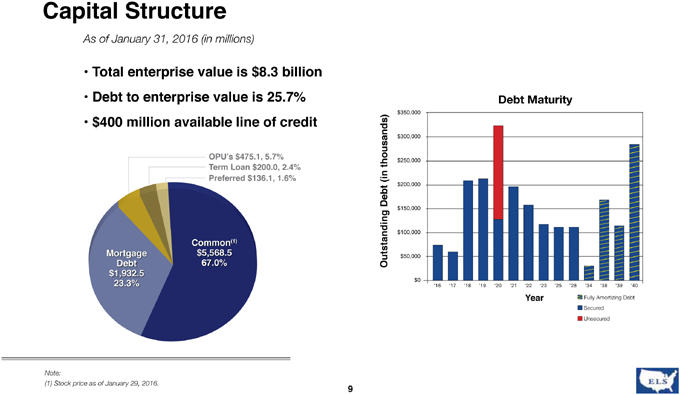
Capital Structure As of January 31, 2016 (in millions) Total enterprise value is $8.3 billion • Debt to enterprise value is 25.7% • $400 million available line of credit Debt Maturity $50,000 $100,000 $150,000 $200,000 $250,000 $300,000 $350,000 2016 2017 2018 2019 2020 2021 2022 2023 2025 2028 2034 2038 2039 2040 Outstanding Debt (in thousands) Year Debt Maturity Note: (1) Stock price as of January 29, 2016OPU’s $475.1, 5.7% Term Loan $200.0, 2.4% Preferred $136.1, 1.6% Mortgage Debt $1,932.5 23.3% Common(1) $5,568.5 67.0% Fully Amortizing Debt Secured Unsecured
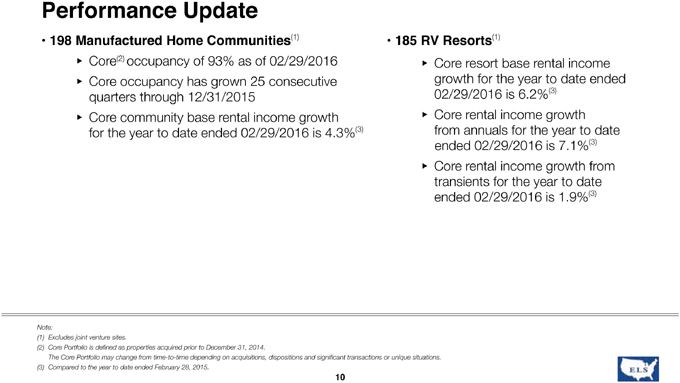
Performance Update 198 Manufactured Home Communities(1) Core(2) occupancy of 93% as of 02/29/2016 Core occupancy has grown 25 consecutive quarters through 12/31/2015 Core community base rental income growth for the year to date ended 02/29/2016 is 4.3%(3) 185 RV Resorts(1) Core resort base rental income growth for the year to date ended 02/29/2016 is 6.2%(3) Core rental income growth from annuals for the year to date ended 02/29/2016 is 7.1%(3) Core rental income growth from transients for the year to date ended 02/29/2016 is 1.9%(3) Note: (1) Excludes joint venture sites. (2) Core Portfolio is defined as properties acquired prior to December 31, 2014. The Core Portfolio may change from time-to-time depending on acquisitions, dispositions and significant transactions or unique situations. (3) Compared to the year to date ended February 28, 2015.
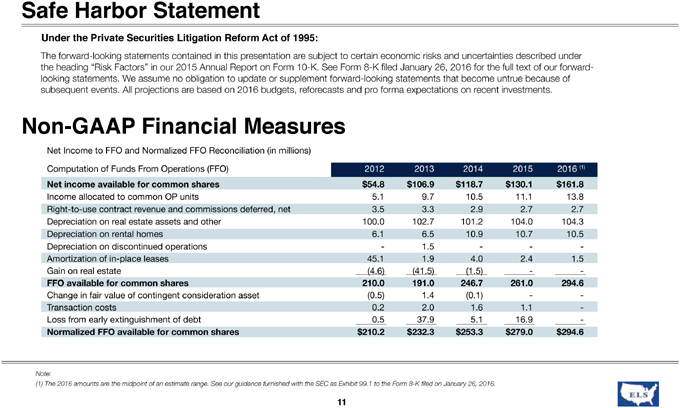
Safe Harbor Statement Under the Private Securities Litigation Reform Act of 1995: The forward-looking statements contained in this presentation are subject to certain economic risks and uncertainties described under the heading “Risk Factors” in our 2015 Annual Report on Form 10-K. See Form 8-K filed January 26, 2016 for the full text of our forwardlooking statements. We assume no obligation to update or supplement forward-looking statements that become untrue because of subsequent events. All projections are based on 2016 budgets, reforecasts and pro forma expectations on recent investments Non-GAAP Financial Measures Net Income to FFO and Normalized FFO Reconciliation (in millions) Computation of Funds From Operations (FFO) Net income available for common shares $54.8 $106.9 $118.7 $130.1 $161.8 Income allocated to common OP units 5.1 9.7 10.5 11.1 13.8 Right-to-use contract revenue and commissions deferred, net 3.5 3.3 2.9 2.7 2.7 Depreciation on real estate assets and other 100.0 102.7 101.2 104.0 104.3 Depreciation on rental homes 6.1 6.5 10.9 10.7 10.5 Depreciation on discontinued operations—1.5 ——Amortization of in-place leases 45.1 1.9 4.0 2.4 1.5 Gain on real estate (4.6) (41.5) (1.5) — FFO available for common shares 210.0 191.0 246.7 261.0 294.6 Change in fair value of contingent consideration asset (0.5) 1.4 (0.1) — Transaction costs 0.2 2.0 1.6 1.1—Loss from early extinguishment of debt 0.5 37.9 5.1 16.9—Normalized FFO available for common shares $210.2 $232.3 $253.3 $279.0 $294.6 Note: (1) The 2016 amounts are the midpoint of an estimate range. See our guidance furnished with the SEC as Exhibit 99.1 to the Form 8-K filed on January 26, 2016.
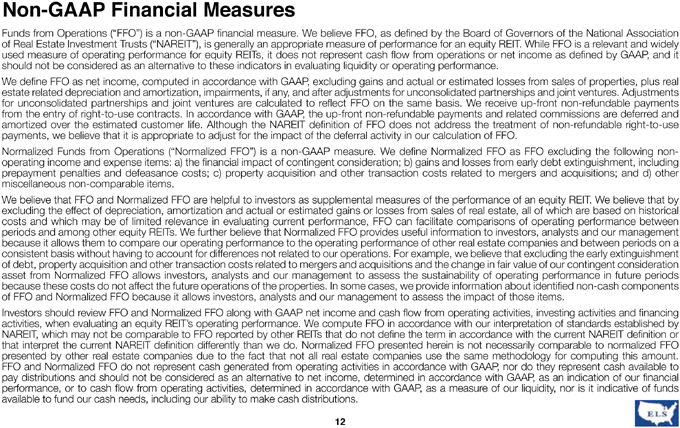
Non-GAAP Financial Measures Funds from Operations (“FFO”) is a non-GAAP financial measure. We believe FFO, as defined by the Board of Governors of the National Association of Real Estate Investment Trusts (“NAREIT”), is generally an appropriate measure of performance for an equity REIT. While FFO is a relevant and widely used measure of operating performance for equity REITs, it does not represent cash flow from operations or net income as defined by GAAP, and it should not be considered as an alternative to these indicators in evaluating liquidity or operating performance. We define FFO as net income, computed in accordance with GAAP, excluding gains and actual or estimated losses from sales of properties, plus real estate related depreciation and amortization, impairments, if any, and after adjustments for unconsolidated partnerships and joint ventures. Adjustments for unconsolidated partnerships and joint ventures are calculated to reflect FFO on the same basis. We receive up-front non-refundable payments from the entry of right-to-use contracts. In accordance with GAAP, the up-front non-refundable payments and related commissions are deferred and amortized over the estimated customer life. Although the NAREIT definition of FFO does not address the treatment of non-refundable right-to-use payments, we believe that it is appropriate to adjust for the impact of the deferral activity in our calculation of FFO. Normalized Funds from Operations (“Normalized FFO”) is a non-GAAP measure. We define Normalized FFO as FFO excluding the following nonoperating income and expense items: a) the financial impact of contingent consideration; b) gains and losses from early debt extinguishment, including prepayment penalties and defeasance costs; c) property acquisition and other transaction costs related to mergers and acquisitions; and d) other miscellaneous non-comparable items. We believe that FFO and Normalized FFO are helpful to investors as supplemental measures of the performance of an equity REIT. We believe that by excluding the effect of depreciation, amortization and actual or estimated gains or losses from sales of real estate, all of which are based on historical costs and which may be of limited relevance in evaluating current performance, FFO can facilitate comparisons of operating performance between periods and among other equity REITs. We further believe that Normalized FFO provides useful information to investors, analysts and our management because it allows them to compare our operating performance to the operating performance of other real estate companies and between periods on a consistent basis without having to account for differences not related to our operations. For example, we believe that excluding the early extinguishment of debt, property acquisition and other transaction costs related to mergers and acquisitions and the change in fair value of our contingent consideration asset from Normalized FFO allows investors, analysts and our management to assess the sustainability of operating performance in future periods because these costs do not affect the future operations of the properties. In some cases, we provide information about identified non-cash components of FFO and Normalized FFO because it allows investors, analysts and our management to assess the impact of those items. Investors should review FFO and Normalized FFO along with GAAP net income and cash flow from operating activities, investing activities and financing activities, when evaluating an equity REIT’s operating performance. We compute FFO in accordance with our interpretation of standards established by NAREIT, which may not be comparable to FFO reported by other REITs that do not define the term in accordance with the current NAREIT definition or that interpret the current NAREIT definition differently than we do. Normalized FFO presented herein is not necessarily comparable to normalized FFO presented by other real estate companies due to the fact that not all real estate companies use the same methodology for computing this amount. FFO and Normalized FFO do not represent cash generated from operating activities in accordance with GAAP, nor do they represent cash available to pay distributions and should not be considered as an alternative to net income, determined in accordance with GAAP, as an indication of our financial performance, or to cash flow from operating activities, determined in accordance with GAAP, as a measure of our liquidity, nor is it indicative of funds available to fund our cash needs, including our ability to make cash distributions.

Equity LifeStyle Properties Two North Riverside Plaza, Chicago, Illinois 60606 800-247-5279 | www.EquityLifeStyle.com
